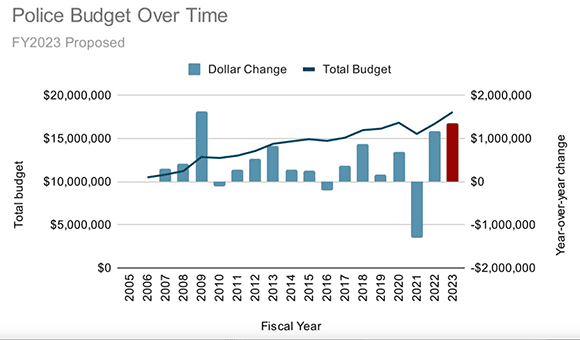(The opinions and views expressed in the commentaries and letters to the Editor of The Somerville Times belong solely to the authors and do not reflect the views or opinions of The Somerville Times, its staff or publishers)

By Chris Dwan
I have heard from people I trust that the police are unable to cover critical services like traffic details for construction and community engagement because the department was “defunded” in the aftermath of George Floyd’s murder in 2020. I have also heard, from other people I trust, that the force is slow-rolling popular initiatives, not for lack of funds, but because the officers are aggrieved at having their motives so publicly questioned.
More briefly: If you listen to enough people around the city, you will hear that we both did and also that we did not defund the police.
I think that a historical perspective might be in order to help resolve this apparent contradiction.
In the 1875 “Annual Report of the City of Somerville,” the Chief of Police – M.C. Parkhurst – writes that “The rapid growth of our city during the past few years, and the act of the Legislature of 1873 respecting Truant Children has very materially increased the labors devolving upon our Police Department.” He writes that the Police force numbered 19 men at that time, including a Chief and a Captain. The Chief “[does] not hesitate to recommend an addition to the force of six or seven men … to secure three reliefs in every twenty-four hours … the labor of the department would be more equally divided, and less special duty would be required.” He also bemoans delays in “the building … designed to meet the requirements of the police … the business of which is now conducted with great inconvenience.” He concludes with a funding ask: “The cost of sustaining this department the past year was about twenty-four thousand dollars, which will necessarily be increased some six or seven thousand dollars if the changes proposed are consummated.”
Nearly 150 years ago, the police were suffering excessive overtime, asking for additional staff to cover un-funded state mandates, and complaining about delays in construction of a new headquarters. It’s shockingly similar to the present-day complaints.
The ledger of accounts in that same report shows payments of about $1,090 to each of 24 patrolmen, plus a Sergeant, Lieutenant, Captain, and Chief. That’s a total of 28 people in 1875, 50% more than the Chief’s claim of a 19-person force, without even counting the 10 “extras” who were paid smaller amounts. The total expenditure for the department according to the finance department was $32k, not $24k, with a similar amount going towards construction of that delayed police station.
This sort of discrepancy will be familiar to anybody who has watched the City Council’s Finance Committee meetings. In civics, it’s often not a question of determining the best number, but of figuring out what the numbers actually are.
Thirty years later, that same Melville C. Parkhurst authored the Police chapter in the Annual Report of 1905. By then the department had grown to “a chief of police, one captain, three lieutenants, four sergeants, one inspector, forty-four regular, and ten reserve patrolmen.” The chief notes that “With our present population,” (69,272 — about 80% of present-day Somerville), “it cannot be said the department is too large.”
The 1905 report notes, “a growing necessity for ways and means to keep pace with the up-to-date methods of criminals in pursuing their calling.” The Chief notes that “horses, as well as human beings, are too slow in their movements to overtake thieves in automobiles.” He recommends the purchase of at least one automobile, which he says might find good additional use “[patrolling] sections where licensed automobilists defy the speed laws, not so much for the purpose of making arrests, but to have a general supervision over and caution such offenders, and command a respect for the laws.” The report also calls for better facilities, noting the “lack of station houses in East Somerville, Winter Hill, and Davis Square.”
I heard much the same pitch at last year’s Ward 2 community meeting, and also as part of a capital request from the Ballantyne administration at a recent meeting of the City Council. If only we had more, and better equipped officers, we might have the capacity to address the modern dangers on our streets and in our neighborhoods.
Skimming ahead through decades of history, the parallels continue. Mayor S. Lester Ralph’s inaugural address in 1970 says: “It has been one of the saddest sights I have ever seen to witness the condition of our school buildings in this city. I consider it absolutely immoral to spend a penny on anything else until we have provided a setting in which our children can study and learn properly, happily and safely. None of these conditions are now present in most of our schools.” Mayor Ralph also says that he is “conferring almost daily with business people … to encourage them to come into Somerville and build high rise office and apartment complexes.”
Our 1970 police department employed 151 officers, including the chief, three deputy chiefs, five captains, nine lieutenants, seventeen sergeants and 115 patrolmen. Chief Thomas O’Brien makes only a brief note in the report, thanking the Mayor, the Aldermen, and the heads of the various departments, “for their loyal support, cooperation and assistance.” At that time, Somerville’s population was 87,000 people – within measurement error of today’s total. That was, give or take, the high-water mark of the department – at least in terms of personnel.
By the 1995 report, the police department was down to 134 officers. Despite that decline, Chief Donald Caliguri submitted a brisk single page report saying that “we have seen a marked decrease in crime in the city … attributed to our increased interaction with the community. The various partnerships formed with social service agencies has also brought about a combined effort at attacking the root cause of much crime and social disorder.”
The last annual report I can find is from 2001, during Mayor Dorothy Kelly Gay’s administration. 22 years ago, we had a population of 77,478 people – 10,000 fewer than six years before. The three listed achievements of the uniformed patrol section were targeting truck restricted roadways, enforcing crosswalk violations, and conducting “selective” traffic enforcement. Unfortunately, that report does not contain budget or staffing details.
So far as I can tell, the city no longer publishes these annual reports – at least not as a singular 200–700-page document that you can find printed at the library on Central Hill, online at https://archive.org, or with the help of our city’s archivist (who is a civic treasure). Instead, we are left to sift through the wealth of confusing and occasionally contradictory data that can be scraped from various websites. The numbers always seem to shift under me as I try to answer simple numerical questions like “did we defund the police in 2020?”
In one jarring example, the website that hosts the current year’s budget, which was approved by the City Council in June, notes that it was last updated on October 17. The revenue section is missing entirely. I am told that this is due to some end-of-year cleanup within the finance department.
The numbers that I and others have been able to gather about the past couple of decades show a one-year dip in funding in 2020 which was more than replaced the following year. Since then, we have resumed a decades long trend in which police funding broadly tracks with inflation, headcount remains steady or gradually drops, and overall crime numbers – both violent and property related – decrease year over year.

In one important sense, though, the police were absolutely defunded in 2020. That year saw a national groundswell of public outrage, demanding accountability and reform in policing. It is tempting to call that social movement “unprecedented,” but having just skimmed 150 years of history – there is plenty of precedent. The report where I started, in 1875, was printed just ten years after General Lee surrendered at Appomattox and President Lincoln was assassinated.
For all that 150 years have passed, the injustices in our society remain fresh and raw, and history is replete with stories of armed forces grown aggrieved and surly against the populations they swore to protect.
Steven Pinker, in his recent book Rationality, says that “each of us has a motive to prefer our truth, but together we’re better off with the truth.” Admiral Rickover, architect of the nuclear navy, said it more bluntly: “Don’t push out figures when facts are going in the opposite direction.”
It is possible to learn from history’s lessons, but it requires discipline, lest we be condemned to repeat them.















Reader Comments